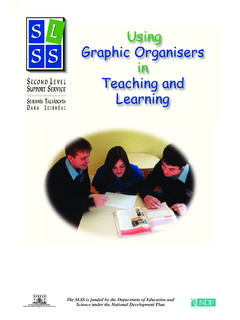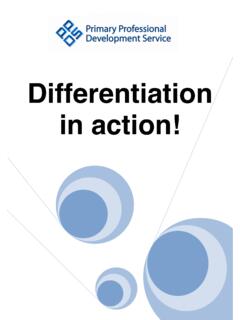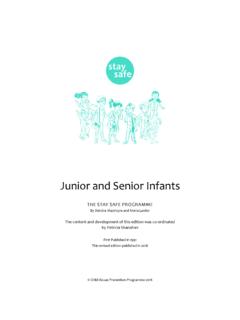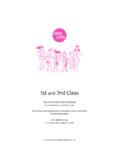Transcription of Guiding Comprehension - PDST
1 [Type text] Guiding Comprehension Teaching for Meaning Guiding Comprehension Teaching For Meaning Comprehension is a process in which readers construct meaning by interacting with text through the combination of prior knowledge and previous experience, information in the text and the stance the reader takes in relationship to the text Pardo, 2004 The teaching of reading needs to include a range of Comprehension strategies. Comprehension strategies can be defined as the mental processes that good readers use to understand text. Comprehension strategies need to be explicitly taught. The diagram below illustrates the 3 levels of Comprehension , ranging from the lower order literal type to the higher order evaluative type.
2 Strategy Definitions and Activities to Support Evaluative Synthesising Determining Importance Summarising and Paraphrasing Self Questioning Inferential Connecting Comparing Inferring Predicting Literal Creating Images Skimming Scanning Self Questioning Reading Strategies Definitions and activities to support implementation ( denotes task card template located at end of resource book) Activities for Creating Images Picture This: Teacher reads a section of a text without showing any illustrations and children draw a visual representation of their interpretation of character/ setting/ event from that piece of text. Sensory Chart: Pairs of children select section of text and record pictorially or using key words what text looks like/ feels like/sounds like. Post Your Senses: Pupils record brief details on post it notes based on images they form as they read text.
3 They stick the post it notes onto the appropriate part of the text. Changing Images: Teacher reads a section of a text without showing any illustrations. Teacher stops reading at a selected place in the text and asks children to sketch or write the mental image they have created. Children label this, Image 1- My First Image. Teacher reads more of the text and children are given time to re-create their image based on the new information. Children label this, Image 2- My Second Image. Children should be asked to discuss any changes made to the second image. Creating Images Readers create images using the senses to help them to draw conclusions, make predictions, interpret information, remember details and assist with overall Comprehension Open Mind Portrait: Children are asked to create character portraits and include key words to describe the character s thoughts and feelings.
4 Information Images: Children create key images based on informational text in a science or nonfiction book. Activities for Self Questioning Clouds of wonder: Pupils discuss text and generate I wonder questions represented on cloud shapes on a sheet. This can be done at regular intervals throughout the reading of a text. Stop and Think Cards: Children are given prompt cards with questions directing them to reflect on their understanding of section of text. Do I understand what that part was about? Could I explain that part to somebody else? Before, During, After Question Sheets: Children compose and record questions in 3 separate columns on a sheet: Before Reading, During Reading, After Reading. Written Conversation: Pairs of children exchange their thoughts and explanations of events in a text with each other in written form- no talking allowed.
5 Self questioning Self-Questioning encourages readers to constantly think of questions before, during and after reading to assist them to comprehend text. Self-formulated questions provide a framework for active reading and engagement as students go in search of the answers. Activities for Skimming Picture Flick: Children are given an opportunity to flick through illustrations to get an initial sense of the contents, characters and settings. They make predictions based on this quick glance at the text. Graphic Overlays: Pupils overlay text with tracing paper/ acetate, and outline chunks of text/ graphs/ headings etc. These sections are labelled on the overlay. This helps with the gathering of information where text is presented in columns interspersed with graphs/ pictures. Sneak Preview: Pupils complete Sneak Preview sheet to gain information before they read the text fully.
6 The sheet can have sections for cover, headings, illustrations, author etc. Children fill in brief details in each section based on a quick skim through the text. After reading the text the children should discuss how their sneak preview prepared them for the text. Skimming This involves glancing quickly through a text to gain a general impression of the content. Graphics, italics and headings are useful cues when skimming a text. Activities for Scanning Hunt the Text Challenge: A set of quiz cards are created with questions seeking specific information page number, date, heading, title etc. Teacher reads out questions and asks children to locate the information as quickly as they can. Beat the Buzzer: Pupils can devise questions as above and record these on cards. Teacher collects all questions and asks them to the entire class.
7 Children giving answers must also locate the page number and/or paragraph in which the answer appears. Retrieval cards: In advance of reading the text the children get a list of headings from the teacher about a piece of text habitat, food, size. Children scan the text to get this information and make generalisations before reading the text fully. This works well for informational texts species of dinosaurs, animals that hibernate etc. Interesting Words Charts: Pupils skim text for new / interesting vocabulary. Teacher records words on Interesting Word Chart along with page and paragraph number. Children are asked to look for clues in the text that might help explain what the word means. They record this contextual clue beside the new word. They can also record their own interpretation of what it means. Finally they are asked to check the meaning in a dictionary/ thesaurus/ glossary.
8 Scanning Scanning involves glancing through material to locate specific details, such as names, dates, places or some particular content. Activities for Predicting Split Images: Students work in pairs. Child A describes and elaborates on illustrations in the text. Child B is not permitted to look. Child B looks at the next picture and builds on Child s A description and prediction. The process of alternating predictions continues until text is completed. Personal Prediction: Children predict using title, author, cover page etc. Children are then given key words from the text and asked to refine their earlier predictions. Check the Text: Teacher hides text and shows only illustrations, diagrams, pictures. Children predict and create their own text to match the illustrations. Crystal Ball : Whole text has been read.
9 Divide children into groups, each group is allocated a character from the text. Each group brainstorms information about their character, likes, dislikes, interests, personality traits that were stated explicitly or implicitly in the text. Then each group predicts the future for their character based on evidence from the original text and shares with other groups. Think Sheets: Key headings and chapter titles are used to construct questions based on the text. Allow children to think/pair/share and suggest answers prior to reading and compare these after having read the text. True/False - Statements about events in the story are recorded by children before reading the text. Children then compare the statements after reading for confirmation/ rejection. Predicting Prediction helps readers to activate their prior knowledge about a topic, so they begin to combine what they know with the new material in the text.
10 Predictions are based on clues in the text such as pictures, illustrations, subtitles and plot. Activities for Connecting Connecting with the text: Children mark areas in the text with post it notes to show places in the text with which they have made a personal connection own experience, previous reading material, similar characters. Before and After Chart: Information is organised on a chart into 3 columns What we know before reading the text What we now know after reading the text What other information we would like to find out Think and share: children list key events in the story on one side of a page/chart. Each child takes on a character from the text and considers how this character was feeling during each event. These thoughts are recorded on the right hand side opposite the particular event. Linking texts: After a number of texts are read, children are asked to list these and illustrate the commonalties between the texts by drawing in linking lines.













